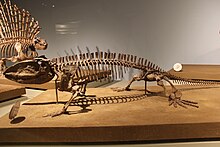
Back أفعواني العيون Arabic Ophiacodon Catalan Ophiacodon German Οφιακόδων Greek Ophiacodon Spanish ماردندان FA Ophiacodon French אופיאקודון HE Ophiacodon ID Ophiacodon Italian
| Ophiacodon Temporal range: Late Carboniferous to Early Permian
| |
|---|---|

| |
| Skeleton of O. mirus in the Field Museum of Natural History, Chicago | |
| Scientific classification | |
| Domain: | Eukaryota |
| Kingdom: | Animalia |
| Phylum: | Chordata |
| Clade: | Synapsida |
| Family: | †Ophiacodontidae |
| Genus: | †Ophiacodon Marsh, 1878 |
| Type species | |
| †Ophiacodon mirus Marsh, 1878
| |
| Other species | |
| |
| Synonyms | |
| |
Ophiacodon (meaning "snake tooth") is an extinct genus of synapsid belonging to the family Ophiacodontidae that lived from the Late Carboniferous to the Early Permian in North America and Europe. The genus was named along with its type species O. mirus by paleontologist Othniel Charles Marsh in 1878 and currently includes five other species.[1] As an ophiacodontid, Ophiacodon is one of the most basal synapsids and is close to the evolutionary line leading to mammals.[2]

- ^ Felice, R. N. & Angielczyk, K. D. (2014). "Was Ophiacodon (Synapsida, Eupelycosauria) a Swimmer? A Test Using Vertebral Dimensions". Early Evolutionary History of the Synapsida. Vertebrate Paleobiology and Paleoanthropology. p. 25. doi:10.1007/978-94-007-6841-3_3. ISBN 978-94-007-6840-6.
- ^ Maddin, H.C.; Evans, D.C. & Reisz, R.R. (2006). "An Early Permian varanodontine varanopid (Synapsida: Eupelycosauria) from the Richards Spur Locality, Oklahoma". Journal of Vertebrate Paleontology. 26 (4): 957–966. doi:10.1671/0272-4634(2006)26[957:aepvvs]2.0.co;2.